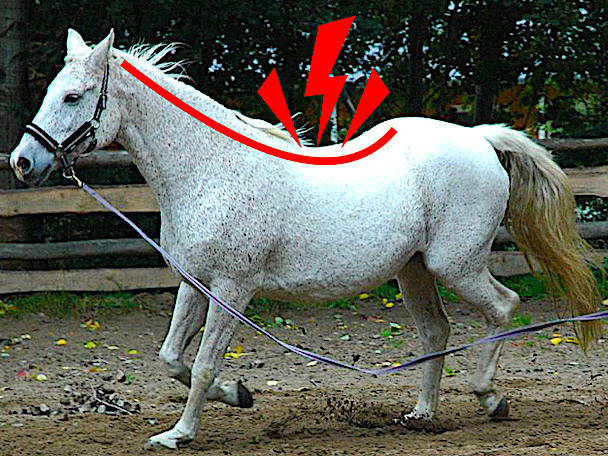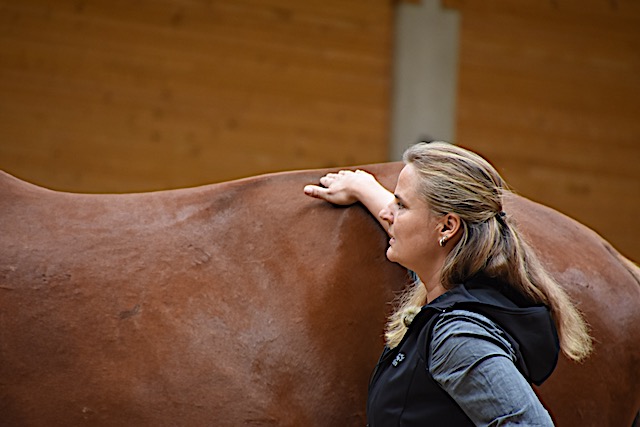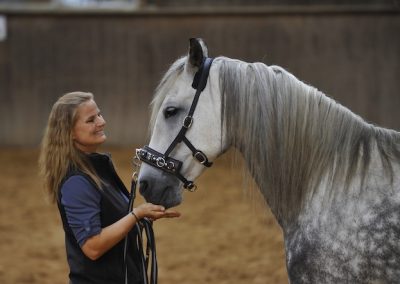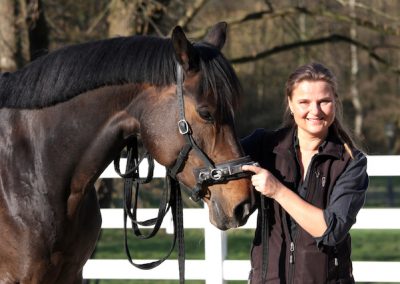Identify if a horse has back problems

In this video, Maike Knifka shows us how layman can examine a horse’s back.
Many horses suffer from back pain
It is a sad fact: Many horses suffer from back pain. Symptoms such as muscle tension, pain and damage in the back area are often rooted in one or multiple of the following mistakes: incorrect horse training, unfitting saddles, too much load on a horses’ back, imbalanced riders, hereditary diseases or debilitations, etc. Horses are not naturally born to carry weight on their back.
Very frequently, back pain in horses remains undetected for a long time. Owners and instructors often mistake pain expressions for naughtiness,stubbornness or rebellion. Knowledge is power, therefore it is important to know manifold symptoms that indicate back pain. Some come naturally to mind, others are difficult to determine. Since many of the listed symptoms could also have other causes, consulting a vet and/or physiotherapist is recommended.

Indications for potential back problems
Symptoms for back pain can be revealed during riding and lunging:
- A horse that is unable to move relaxed and supple. It raises its head.
- A horse that refuses to move or balks.
- A horse that moves hectically, bucks, rears or bolts.
- The horse’s back sways down instead of up.
- Bulging lower neck muscles.
- The horse refuses to bend or position itself throughout its body.
- Tilting of the poll.
- Head tossing.
- Tail swishing.
- A horse that doesn’t lift its legs and drags the hind leg hooves.
- Loss of rhythm, stiffness or lameness.
- Reluctance to canter, picking up the wrong canter lead, disunited canter.
- Groaning sound from the sheath (the “gelding noise”)
Additional symptoms can occur during riding:
- Horse is difficult for the rider to sit on.
- Horse doesn’t move willingly forward.
- Hyperflexion of the neck.
- Horse roots the reins out of rider hands.
- Horse that cannot square up.
- Refusal to jump.
Other peculiarities that can indicate back pain:
- Horse reacts when its back is touched during grooming (swerves)
- Horse is fretful or restless when being saddled or during mounting. It is openly aggressive, tries to snap at the saddle or even bites.
- Horse kneels down when being saddled or during mounting.
- Horse stands and walks with a tucked tail. Its tail is raised or tilted to one side.
- Hind legs are noticeably extended backwards.
- Horse refuses to lift back hooves and pulls them away.
- Horse expresses pain in its face, seems stressed, or shows aggression during handling.
- Horse rarely plays with other horses, does not like to move and appears sluggish or apathetic.
Any of these symptoms, especially if they occur frequently, should raise our attention. Most reasons for unusual behavior root in health complaints and not in a lack of respect or bad habits. Remember, horses cannot verbally express their pain. But if we are willing to pay attention, we will realize when our horse is in pain.
Can a horse with pain still be ridden?
A common question I get asked is “Can I still ride my horse even if I suspect any back pain?”. I hope this question becomes obsolete. I like to take a clear position in this: No! As soon as I think my horse is experiencing pain, whether in its back, hooves, teeth or anywhere else, it should not be ridden! Riding a horse in pain in an unfavorable act. These horses require thorough diagnosis and treatment.
I recommend “A Course in Lunging” which teaches you how to properly train your horse from the ground and without any weight on its back.
Did you like the article?
Share your experiences…



0 Comments